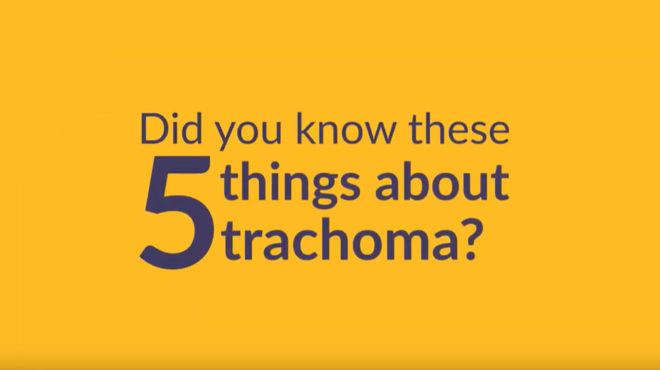Trachoma is the world’s leading infectious cause of blindness. Without treatment, it can cause permanent sight loss.
Trachoma: causes, symptoms and treatment
What is trachoma?
Trachoma is an infectious eye disease that begins as a bacterial infection. At first, the infection can be easily treated. But repeated infections will lead to advanced trachoma, which can cause intense pain and lead to blindness.
Trachoma is one of a group of conditions known as neglected tropical diseases.
According to the World Health Organization, more than 103 million people worldwide are at risk of going blind from trachoma, with the highest number of cases worldwide found in Africa, particularly in Ethiopia, Sudan and South Sudan. The disease is more likely to affect people in rural areas, where there is limited access to health care.
What causes trachoma?
The disease is caused by the bacteria known as ‘chlamydia trachomatis’. It thrives in places with water shortages, poor sanitation and infestations of flies.
Trachoma spreads through contact with flies that carry the bacteria, or via hands, clothes or bedding that have been in contact with an infected person.
Women are more likely to be affected by trachoma, because their caregiving role means they often have close contact with children with the eye infection. Globally, women are 1.8 times more likely than men to be blinded by the disease.

“When I open and close my eyes, I can see hair scratching them.”
Read Mohamed’s storyWhat is trichiasis?
Trichiasis is an eye condition caused by repeated trachoma infections, which irritate the eye and cause scar tissue to build up inside the eyelid. The upper eyelids tend to be most affected by trachoma. Trichiasis makes the eyelid tight and pulls the eyelashes inwards, causing them to angle towards the eye, instead of away from it.
The eyelashes then scrape painfully against the eyeball, which eventually causes permanent damage, leading to blindness.
People with trichiasis often say it feels like having sand in their eyes. They may resort to pulling out their eyelashes to ease the pain.
Trichiasis is sometimes called ‘advanced trachoma’, as it can happen after repeated infections.
Preventing trachoma and treating trichiasis
The World Health Organization’s SAFE strategy aims to stop the spread of trachoma and treat people with the advanced stage of the disease. The acronym describes the four methods used to control the disease.
- Surgery: an operation can stop the eyelashes from rubbing against the eyeball and help to prevent blindness or further sight loss.
- Antibiotics: giving antibiotics to communities helps to treat the infection and reduce its spread. This can be repeated annually for up to five years or more, depending on the level of infection within a community.
- Facial cleanliness: it’s vital to educate communities about the importance of face washing and maintaining good hygiene, which helps to prevent the disease from being passed from person to person.
- Environmental improvements: ensuring people have clean water and sanitation reduces their chances of being exposed to the infection, and helps to avoid the conditions that allow flies to breed.
We’re working with communities to improve access to water, sanitation and hygiene, known as WASH, and teaching children about the importance of hygiene in beating neglected tropical diseases.

“My eyes hurt and felt like they had sand in them. Someone said I should buy razor blades to cut my eyelashes.”
Achiwa, former trachoma patient
The best part of my job is when I reach someone with trichiasis and I can save their sight.

Find out about other diseases we treat
Neglected tropical diseasesHow you can help
Our aim is to eliminate trachoma in the countries where we work, and this goal is now closer than ever.
We’ve already supported six countries to eliminate the disease. Yet there are still more than 39 countries that count trachoma as a public health problem. Our Accelerate programme aims to support at least 15 countries to eliminate trachoma by 2027.
Without action, millions of people face the pain and agony of advanced trachoma. It can limit a child’s independence and access to education, and lead to a cycle of poverty as people are unable to work and provide for their families.
But with your support, our life-changing charity work can reach even more people with medication to prevent the disease from spreading, and provide operations for those at risk of blindness.
Page last reviewed: November 2024
Next review due: November 2027
Learn how we produce our web content

